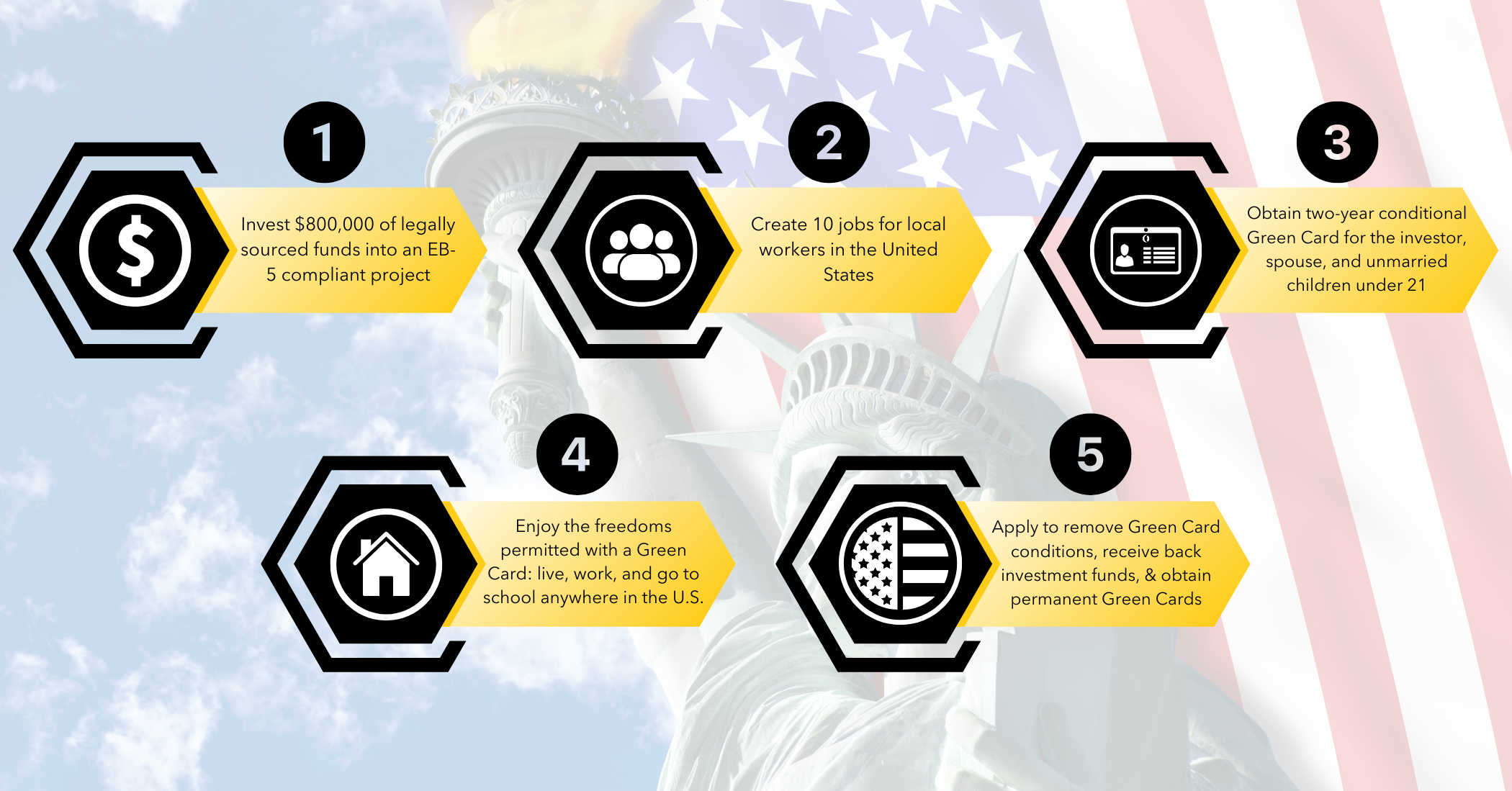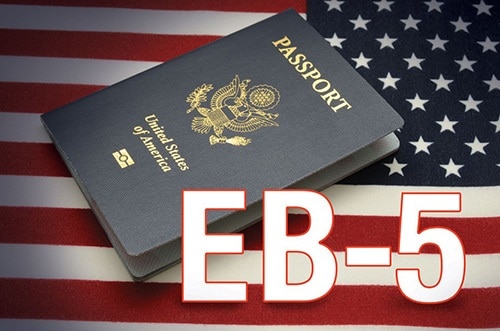Investor’s guide to preparing your EB-5 visa
Wiki Article
EB-5 Visa Explained: Just How to Obtain a Visa Via Financial Investment
The EB-5 Visa program offers a distinct chance for foreign investors looking for united state long-term residency via an organized investment method. With particular eligibility standards and investment limits, the procedure requires cautious consideration and critical preparation. Comprehending the nuances of the application process, consisting of the differences in between local centers and direct investments, is vital for possible candidates. As this pathway unfolds, potential capitalists should browse various advantages and challenges that accompany it. What are the vital aspects that can influence the success of an EB-5 application?Introduction of EB-5 Visa
The EB-5 Visa program, developed to promote the U.S. economic climate through international investment, uses a pathway to permanent residency for qualified investors and their family members. Developed by the Immigration Act of 1990, the program intends to attract international funding to develop work and enhance economic growth in the USA. Capitalists that add a minimal quantity to an authorized project can get this visa, thereby permitting them to spend in numerous industries, including realty, infrastructure, and various other commercial enterprises.The EB-5 program is particularly appealing due to its dual advantages: an opportunity for financial returns on financial investments and the possibility for united state citizenship. By investing in targeted employment locations (TEAs), which are specified as country regions or areas with high joblessness, financiers might get a decreased investment threshold. The program calls for the development of at the very least ten full-time jobs for united state workers as a direct result of the investment. Successful candidates receive a conditional visa for 2 years, after which they can look for permanent residency, offered they meet all program needs. This path has actually gathered interest from investors worldwide, making it a vital component of U.S. immigration plan.
Eligibility Requirements
To certify for the EB-5 Visa, capitalists should fulfill specific eligibility criteria that assure their investment adds to task creation and financial development in the USA - EB-5 Investment Amount. Candidates must spend a minimum of $1 million in a new industrial venture, or $500,000 if the investment is made in a targeted work area (TEA), which is commonly characterized by high joblessness or rural locations.Additionally, the venture has to preserve or produce at the very least 10 permanent work for qualifying united state employees within 2 years of the capitalist's admission to the United States. Financiers are also needed to show that their investment funds were gotten through authorized ways, giving evidence such as income tax return and bank declarations.
An additional vital requirement is that the financial investment should remain in a for-profit service entity that was developed after November 29, 1990, or one that has been restructured or expanded to meet the EB-5 requirements. Candidates need to demonstrate their intent to proactively take part in the company, making certain that their involvement contributes to its success. Fulfilling these qualification needs is essential for capitalists looking for to get long-term residency through the EB-5 program.
Investment Options
When taking into consideration the EB-5 visa, financiers should assess their alternatives between straight investment possibilities and regional facility programs. Each option lugs specific work creation demands that are critical for satisfying the visa criteria. Recognizing these investment opportunities is crucial for making an educated decision that lines up with both monetary goals and migration goals.Direct Financial Investment Opportunities
Direct financial investment opportunities under the EB-5 Visa program provide international capitalists with a pathway to get U.S. long-term residency while adding to the American economic climate. Unlike regional facility financial investments, straight investments require capitalists to actively handle their organization ventures within the united state, enabling prospective higher control and impact over their investment end results.To certify for the EB-5 Visa through direct investment, international nationals have to invest a minimum of $1 million in a brand-new business or $500,000 in a targeted work area, which is defined as a rural location or an area with high unemployment. The investment has to lead to the creation of a minimum of 10 full-time jobs for qualifying united state workers within two years.
Direct financial investment alternatives can differ widely, including industries such as real estate development, production, friendliness, and technology start-ups. Investors have to conduct detailed due diligence to assess the viability of their chosen service version and guarantee compliance with EB-5 regulations. Involving with financial and legal professionals experienced in EB-5 matters is advisable to navigate the intricacies of direct financial investment chances and take full advantage of the possibility for an effective application.
Regional Center Programs
Leveraging the EB-5 Visa program, regional facility programs supply a streamlined investment opportunity for foreign nationals seeking united state irreversible residency. These programs are designated by the united state Citizenship and Migration Services (USCIS) and focus on pooling investments to fund different financial development tasks, which might include property, infrastructure, and service ventures.Investors typically add a minimum of $900,000 in targeted employment areas or $1.8 million in other areas. EB-5. One of the main advantages of regional facility programs is that they allow investors to satisfy the EB-5 financial investment needs with indirect job production, as opposed to route job development called for in straight financial investment possibilities
Regional focuses take care of the financial investment in support of the capitalists, using a much more passive method than direct financial investment. This administration consists of looking after job development, monetary reporting, and compliance with USCIS policies. In addition, regional facilities commonly have developed record, improving the self-confidence of possible capitalists.
Inevitably, regional center programs provide a compelling alternative for those aiming to navigate the intricacies of the EB-5 Visa procedure while adding to united state financial development and job production.
Work Production Requirements
To get an EB-5 Visa, capitalists need to confirm that their capital expense causes the development of at least 10 permanent work for U.S. workers within two years. This job development requirement is an essential part of the EB-5 program, designed to stimulate the U.S. economic situation and promote economic development.Financiers can choose in between two main financial investment options: straight investments and financial investments via Regional Centers. With direct investments, the financier needs to proactively handle the organization and assurance work development, while likewise demonstrating that the jobs produced are for U.S. people or legal irreversible citizens. On The Other Hand, Regional Facility investments allow financiers to merge their sources right into a designated task, frequently causing indirect task creation, which can be counted in the direction of satisfying the task requirement.
To efficiently fulfill the job creation criteria, it is essential for capitalists to function carefully with knowledgeable professionals who can direct them through the intricacies of the EB-5 program. Appropriate preparation and adherence to policies are important to confirm compliance and safeguard a course to irreversible residency. Failing to fulfill these work creation needs can threaten the capitalist's EB-5 application and their migration status.
The Application Process
The application procedure for the EB-5 visa involves a series of crucial actions and specific eligibility demands that applicants need to meet. Recognizing these standards is essential for an effective application. This area will certainly describe the necessary credentials and give a detailed guide to guiding with the process.
Eligibility Demands Introduction
Comprehending the eligibility needs for the EB-5 visa is important for possible financiers seeking to obtain long-term residency in the USA. To certify, an individual need to demonstrate a minimum investment of $1 million in a new company, or $500,000 if the financial investment is made in a Targeted Employment Location (TEA), which is specified as a rural location or one with high unemployment.The investor has to reveal that the investment will produce or maintain at least 10 full-time work for United state employees within 2 years of the financial investment. The venture has to also be a for-profit entity and has to be recently developed or substantially redesigned if it is an existing business.
The candidate needs to verify that the mutual fund are gotten through authorized means, consisting of personal financial savings, gifts, or lendings supported by appropriate paperwork. Furthermore, the investor has to actively join the service, ensuring their involvement in the monitoring of the business. Satisfying these eligibility criteria is important for an effective EB-5 application and eventually securing an environment-friendly card with this financial investment method.
Step-by-Step Treatment
Once qualification needs are satisfied, prospective capitalists can start the application process for the EB-5 visa. The initial step includes completing Type I-526, the Immigrant Petition by Alien Capitalist. This form must be gone along with by supporting paperwork that demonstrates the financier's qualifying financial investment and the production of a minimum of ten permanent tasks for U.S. employees.Upon authorization of Kind I-526 by the USA Citizenship and Migration Services (USCIS), investors can look for the EB-5 visa through either consular handling or adjustment of condition, relying on their existing residency. For those outside the united state, this suggests sending a visa at an U.S. consular office. Alternatively, if currently in the united state, applicants should submit Type I-485, Application to Register Permanent House or Change Standing.
After approval, investors and their eligible relative receive conditional permanent residency for 2 years. Within 90 days before the expiration of this conditional status, investors must submit Kind I-829, Application by Business Owner to Remove Conditions, to acquire irreversible residency. Effective completion of this action wraps up the EB-5 financial investment procedure, providing the investor a Visa.
Regional Centers vs. Straight Investments
Navigating the EB-5 visa program includes an important choice in between local facilities and direct financial investments, each offering distinctive paths to getting permanent residency in the United States - EB-5 Visa by Investment. Regional facilities are designated by the United States Citizenship and Immigration Provider (USCIS) to promote financial growth through task development. When spending with a regional center, investors commonly contribute to a pooled fund, which is handled by the. This option frequently enables for a much more easy investment approach, as the center manages the task and task development demandsIn comparison, direct investments require financiers to actively manage their own service endeavors in the USA. This approach necessitates an extra hands-on participation, as the investor must sustain and produce at the very least 10 permanent jobs directly pertaining to their business. While straight investments may offer better control over the financial investment end result, they likewise entail greater dangers and duties.
Inevitably, the choice in between direct investments and local facilities pivots on private threat resistance, wanted involvement degree, and investment objectives. Understanding these differences is vital for financiers seeking to navigate the complexities of the EB-5 visa program effectively.
Benefits of the EB-5 Visa
The EB-5 visa program provides countless benefits for international investors seeking permanent residency in the United States. One of one of the most substantial advantages is the chance for financiers and their instant household members, consisting of partners and children under 21, to get a copyright, giving them the right to function and live in the united state forever.
Furthermore, the EB-5 program does not require an enroller, allowing financiers better autonomy in their migration journey. This program likewise offers a path to citizenship after 5 years of long-term residency, assisting in lasting stability for households. In addition, spending via assigned Regional Centers can be less cumbersome, as these entities often handle the project and task production requirements in behalf of the capitalist.
Additionally, the EB-5 visa can cause significant financial returns, as financial investments are normally directed towards business that can pay. Lastly, by adding to economic growth and task creation in the U.S., EB-5 capitalists play a crucial role in improving neighborhood communities. In general, the EB-5 visa serves as an engaging option for those wanting to secure a future in the USA while making a positive effect.
Typical Difficulties and Considerations
While the EB-5 visa program offers eye-catching advantages for international financiers, it likewise comes with its share of challenges and factors to consider that potential candidates ought to thoroughly evaluate. One significant challenge is the financial commitment involved, as the minimal financial investment amount is considerable, commonly established at $1 million or $500,000 in targeted work areas. Financiers have to ensure that they have adequate capital and a clear understanding of the connected threats.
Additionally, potential financiers must perform thorough due persistance on the financial investment jobs to prevent fraudulent schemes. The success of an EB-5 application rests on the development of at least 10 permanent tasks for united state workers, requiring careful preparation and surveillance of the business's efficiency (EB-5). Ultimately, maneuvering these difficulties requires a critical strategy and commonly the guidance of experienced professionals in migration and investment regulation
Often Asked Inquiries
For how long Does the EB-5 Visa Process Commonly Take?

Can Family Members Apply With the Main EB-5 Candidate?
Yes, family participants can apply alongside the primary candidate. EB-5 Visa by Investment. Qualified dependents generally consist of partners and single kids under 21, allowing them to acquire eco-friendly cards contingent upon the primary applicant's effective visa approvalWhat Occurs if My Financial Investment Fails?
If your financial investment fails, it may jeopardize your immigration status click to find out more and the potential for acquiring a copyright. It's important to conduct extensive due diligence and think about danger mitigation techniques before proceeding with any kind of financial investment.Are There Age Restrictions for EB-5 Investors?
There are no details age constraints for EB-5 financiers; nevertheless, the individual have to be at least 18 years old to legitimately get in right into financial investment contracts. Minors may certify via adult financial investment and sponsorship.Can I Travel Outside the U.S. Throughout the Application Process?
Traveling outside the U.S. throughout the application process might impact your standing. It is suggested to seek advice from an immigration attorney to understand prospective risks and assurance compliance with all demands while your application is pending.Regional centers handle the financial investment on part of the capitalists, using a more passive technique than direct investment. To qualify for an EB-5 Visa, financiers should validate that their capital financial investment results in the creation of at least ten full time tasks for U.S. workers within two years. Investors can select in between 2 key financial investment alternatives: direct investments and financial investments via Regional Centers. The financier has to reveal that the financial investment will certainly maintain or develop at least ten permanent work for U.S. workers within two years of the investment. Eventually, the choice between local centers and straight investments pivots on specific risk resistance, desired participation degree, and financial investment goals.
Report this wiki page